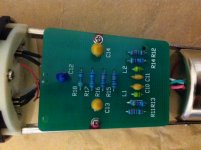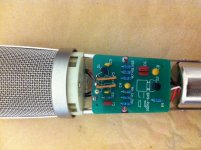Im new to electronics but I'm keen to learn more and get involved with building my own equipment. I understand the basics of how each electronic component works and want to apply this knowledge to something i Use regularly. I have started taking apart a cardiod large diaphragm condenser microphone. Again I know how the basics of how the microphone works but am unsure of what the different circuits between the Capsule and the output are. I would really appreciate it if someone could point me in the right direction. Thank you.
Images of the microphone circuits are (or should be attached).
Images of the microphone circuits are (or should be attached).
Your question may get better response in the Yahoo "micbuilders" group at micbuilders : micbuilders
Dale
Dale
Thank you both for the response ill definitely have a look at the mic idlers group. Ad ill try and upload some jpegs.
Dan.
Dan.


Am I right in saying one of the circuits is a preamp and the other deals with the incoming 48volt phantom power? I realise with the two switches for Low cut and -10b theres more circuitry there but I would just like to know the basics of what would be needed to allow the microphone to function correctly without any additional features.
I would just like to know the basics of what would be needed to allow the microphone to function correctly without any additional features.
Do a search for 'condenser microphone preamp phantom power' and sort through the results. You'll probably want to check what capsule you have to find out if it is an electret or not and how many wires connect to it, etc...
There are standard circuits for 48V phantom power. You might want to define your problem more as I am not entirely sure what your goal is.
edit - here's a nice article:
http://www.thatcorp.com/datashts/AES129_Designing_Mic_Preamps.pdf
Last edited:
What brand and model mic is this? There's a reasonable chance there's a schematic of it somewhere online.Am I right in saying one of the circuits is a preamp and the other deals with the incoming 48volt phantom power? I realise with the two switches for Low cut and -10b theres more circuitry there but I would just like to know the basics of what would be needed to allow the microphone to function correctly without any additional features.
"Preamp" isn't quite the right word for the circuitry that connects to the capsule - maybe "buffer amp" would be better. If it's a non-electret condenser element, it needs an external FET to buffer the very-high-impedance signal from the capsule, and that would be on one of the circuit boards. Otherwise, electret mic elements usually have a FET built in that does this.
Regardless, it's hard to know offhand what each circuit board does, or the function of everything in the whole circuit without a full schematic diagram.
That's a neat article, but it describes the preamp on the other end of a phantom powered balanced mic cable.Do a search for 'condenser microphone preamp phantom power' and sort through the results. You'll probably want to check what capsule you have to find out if it is an electret or not and how many wires connect to it, etc...
There are standard circuits for 48V phantom power. You might want to define your problem more as I am not entirely sure what your goal is.
edit - here's a nice article:
http://www.thatcorp.com/datashts/AES129_Designing_Mic_Preamps.pdf
There's a schematic and I think short description of a (non-electret) condenser mic in the book "The Art of Electronics" second edition.
There's also this forum where they build mics and other studio equipment: http://groupdiy.com
Thank you for your replays its help clear a few things up and the article on the preamp was definitely worth a read so thanks for the link the microphone pictured isn't an electret microphone it's a cheap large diaphragm condenser ( t- bone sc450 not USB ) it has a cardioid pickup Pattern only and has a switches for a -10db pad and another to activate a high pass filter. I've tried looking for an exact schematic but can't find one so figure I'd try for something more popular like the NT 1 a. The aim is just to find out the barebones of what the circuit is that is allowing the capsule to function propyl as a microphone. I have a capsule bases on an m7 microphone capsule which I'm I'm then hoping to add to a circuit and create a basic functioning microphone. The only problem I've had is that I didn't realise how many different ways there was of doing it.
- Status
- Not open for further replies.
- Home
- General Interest
- Everything Else
- Condenser Microphone Circuit Help!